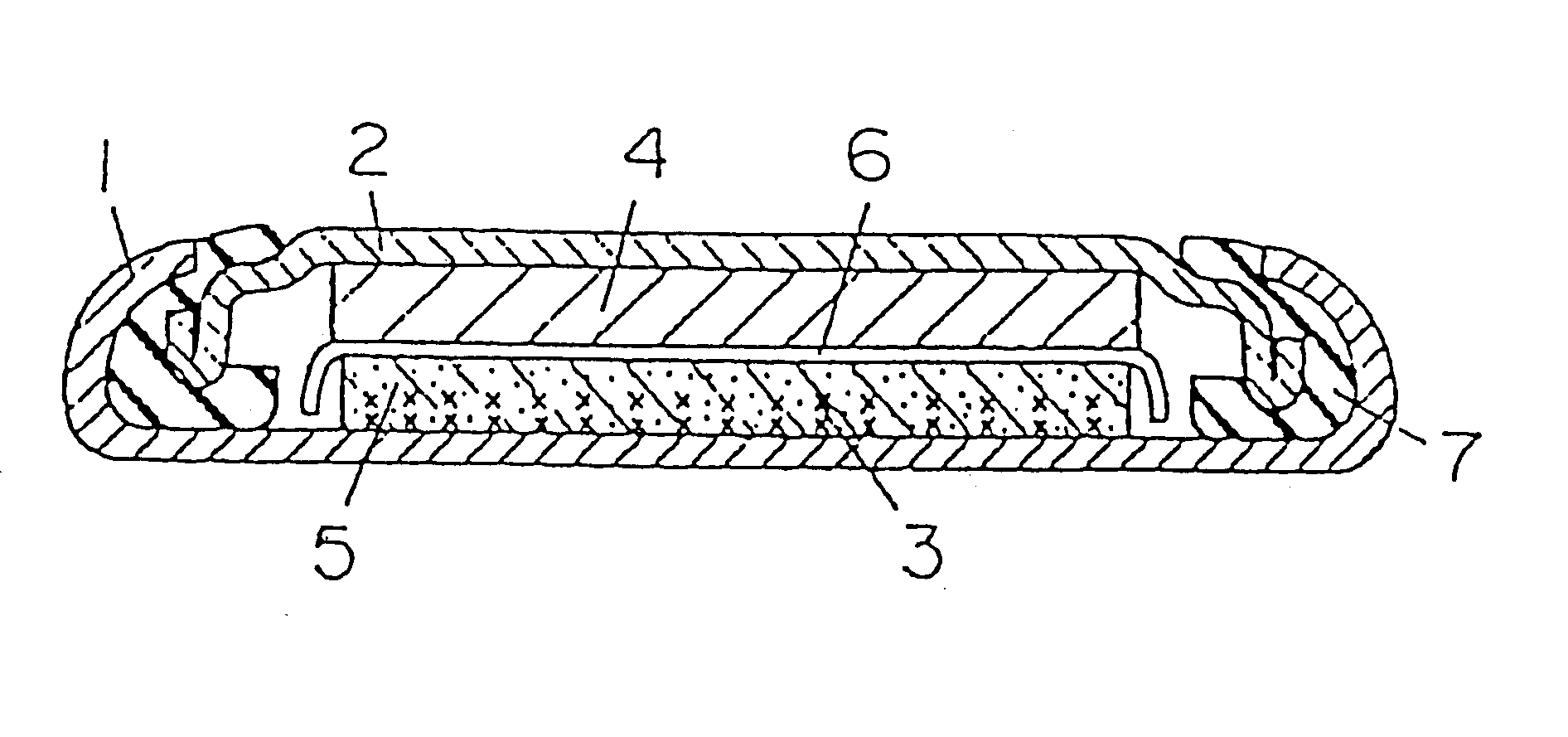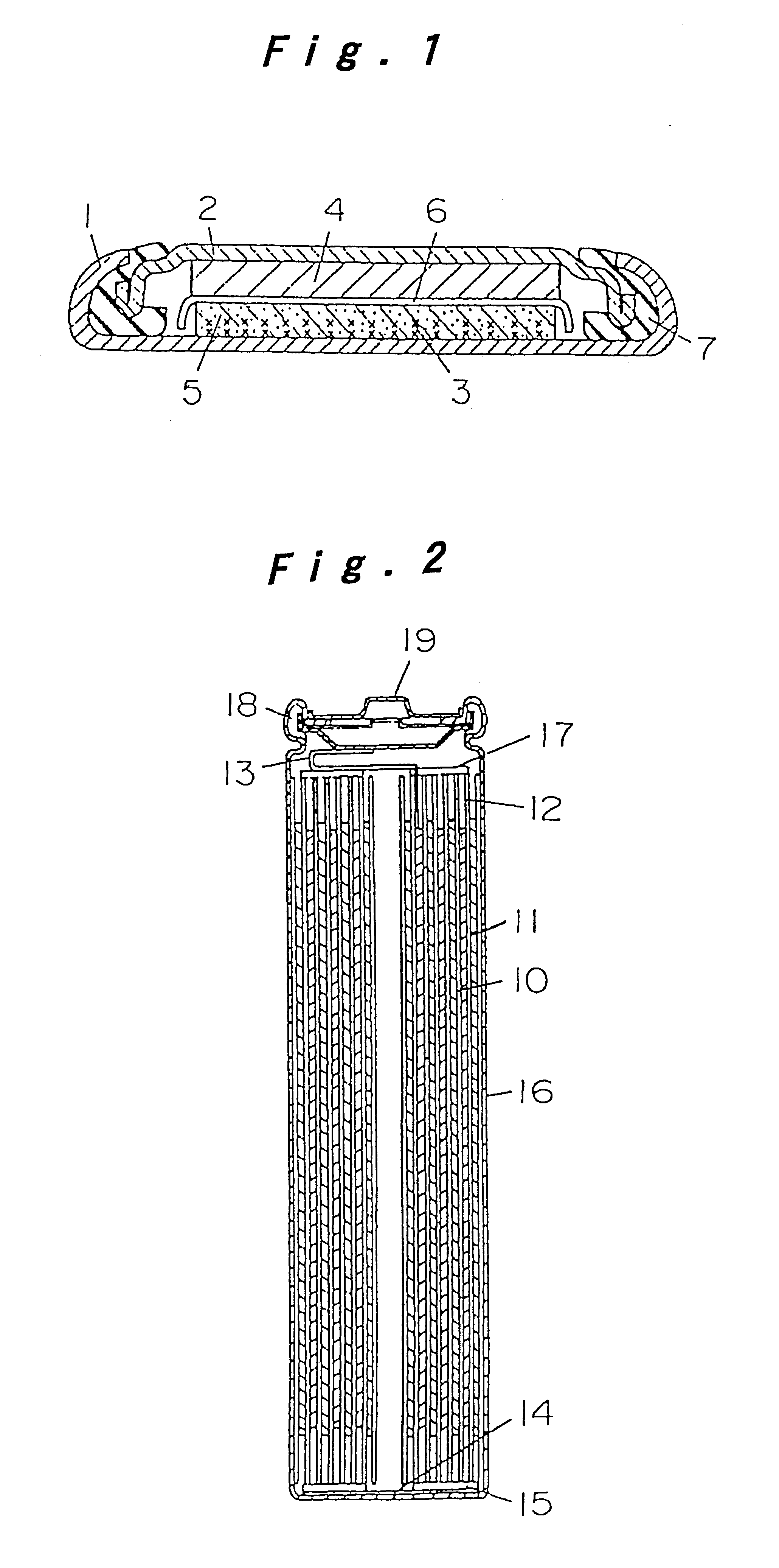Nonaqueous electrolyte secondary cell with a plural-layer carbonaceous negative electrode
a carbonaceous negative electrode, nonaqueous electrolyte technology, applied in cell components, electrochemical generators, transportation and packaging, etc., can solve the problems of internal short circuit, inability to extend the cycle life of repeated charge and discharge, and poor particularyl discharge characteristics of metal lithium for a negative electrode, etc., to achieve excellent high-rate discharge characteristic, enhanced specific capacity, and excellent discharge characteristics
- Summary
- Abstract
- Description
- Claims
- Application Information
AI Technical Summary
Benefits of technology
Problems solved by technology
Method used
Image
Examples
embodiments
(Embodiments)
Referring now to the drawings and tables, preferred embodiments of the present invention will be hereinafter described in detail.
(Measuring Methods)
(1) Mean Particle Size by Reference to Volume
About 1 cc of 2 vol % aqueous solution of polyoxyethylene (20) sorbitan monolaurate was premixed as a surface active agent in the carbonaceous powder, and then using ion exchange water as a dispersant, the mean particle size by reference to volume (median diameter) was measured by means of laser diffraction type particle size distribution meter LA-700 of Horiba.
(2) Tapping Density
Using a sieve of 300-micron opening size for passing samples, the powder was dropped in a 20 cc tapping cell until it is filled up, tapping was repeated with a stroke length of 10 mm by 1000 times, and the tapping density was measured by means of powder density measuring instrument Tap Denser KYT-3000 of Seishin Kigyosha.
(3) Measurement of Specific Surface Area by BET
After heating to 350.degree. C. as pre...
experiment 1
(Basic Experiment 1)
FIG. 1 is a sectional view of a coin type cell for measuring the reversible capacity and irreversible capacity or the negative electrode of a lithium ion secondary cell. In FIG. 1, a grid 3 of stainless steel expanded metal is preliminarily spot-welded to the inner bottom of a stainless steel cell case 1, and this grid 3 and a compound mainly composed of the carbon powder for negative electrode of lithium ion secondary cell are integrally fixed as a carbon electrode 5 by an internal forming method. The compound of the carbon electrode 5 is a mixture of a sample carbon powder and an acrylic binder at a ratio of 100:5 by weight. A polypropylene gasket is fitted to the brim of a stainless steel lid 2, and metal lithium 4 is pressed to the inner surface of the lid 2. After injecting and impregnating nonaqueous electrolyte to the carbon electrode 5, the lid 2 with the gasket is coupled to the cell case 1 through a separator 6 of micro-porous polyethylene film, and the...
experiment 2
(Basic Experiment 2)
Using the same carbon powder materials for negative electrode (sample Nos. 1 to 17) of which reversible capacity and irreversible capacity were determined in the basic experiment 1, cylindrical cells were fabricated, and the high rate discharge characteristic at a low temperature and electrolyte leak possibility when left at a high temperature in a charged state were investigated.
FIG. 2 is a sectional view of a cylindrical cell of spiral electrode group configuration. In FIG. 2, a band-like positive electrode 10 and a negative electrode 11 are spirally wound with a separator 12 made of micro-porous polyethylene film interposed therebetween, thereby constituting an electrode group. The positive electrode 10 is prepared by mixing LiCoO.sub.2 which is a composite oxide of lithium and cobalt or active materials, carbon black as conductive material, and polytetrafluoroethylene (PTFE) as a binder at a ratio of 100:3:10 by weight, applying this paste on both sides of an...
PUM
| Property | Measurement | Unit |
|---|---|---|
| particle size | aaaaa | aaaaa |
| particle size | aaaaa | aaaaa |
| particle size | aaaaa | aaaaa |
Abstract
Description
Claims
Application Information
 Login to View More
Login to View More - R&D
- Intellectual Property
- Life Sciences
- Materials
- Tech Scout
- Unparalleled Data Quality
- Higher Quality Content
- 60% Fewer Hallucinations
Browse by: Latest US Patents, China's latest patents, Technical Efficacy Thesaurus, Application Domain, Technology Topic, Popular Technical Reports.
© 2025 PatSnap. All rights reserved.Legal|Privacy policy|Modern Slavery Act Transparency Statement|Sitemap|About US| Contact US: help@patsnap.com


